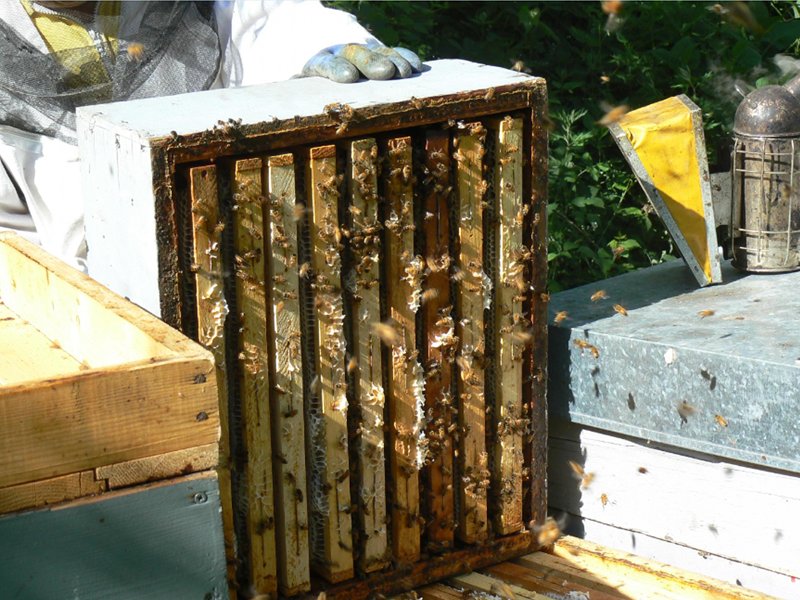Honey from the Ligurian Alps
Characteristic:
The main elements of honey are fructose, glucose, water, other sugars and other substances, such as organic acids, mineral salts and enzymes. Honey is a food of high nutritional value, easily digested. Glucose supplies the energy of immediate use, fructose is metabolized becoming an energetic reserve. One hundred grams of honey supply 320 calories and have a high sweetening property.
In the Park's valleys, especially in the Upper Arroscia Valley (municipalities of Cosio d'Arroscia, Mendatica and Montegrosso), there are beekeeping farms (some of them with organic certification) that produce excellent honey, also thanks to the extraordinary plant biodiversity and to the widespread presence of chestnut trees and mountain flowers (Rhododendron, etc…). In fact there are many honey types in the Ligurian Alps:
Black locust (Robinia). Color: very light. Taste: light, delicate, it reminds of the sweet taste of the ripe fruit. Crystallization: very late, almost absent.
Chestnut (castanea sativa). Color: dark. Taste: strong, persistent, intense. Crystallization: very late, almost absent.
Polyfloral. Color: from light walnut to dark walnut, depending on the year. Taste: characteristic and palatable. Crystallization: subtle, regular, compact.
Basswood (tilia sp.). Color: light amber. Taste: quiet strong, intense, with a lightly bitter aftertaste. Crystallization: slow and irregular, large crystals develop.
Rhododendron (rhododendron sp.). Color: very light, white in the crystallized parts. Taste: very typical, with a harmonious and full tone. Crystallization: quick with thin crystals.
High mountain. Color: amber. Taste: light but persistent, with a palatable aftertaste. Crystallization: quick with thin crystals.
Eucalyptus. Color: light amber. Taste: persistent.
Besides the honey, the Park's farms also produce pollen, propolis and royal jelly. Pollen is the fecundating component of flowers, it appears as a thin powder of different colors, depending on the flower of origin, ranging from off-white to pink, from yellow to green, from red to dark brown. Each speck is a perfect and complete biological unit containing everything that is necessary to live: proteins, vitamins, sugars, amino acids, fats, carbohydrates, enzymes, coenzymes, growth hormones and mineral salts. Pollen also contains many important elements such as potassium, iron, sodium, phosphorus, chlorine, sulphur, nickel, magnesium, silver, zinc, iridium, cobalt, titanium.
Thanks to its richness in proteins, amino acids and vitamins, pollen is a very good food supplement.
Propolis is a resinous substance picked up by the bees from the buds of some plants. It is one of the most effective products as far as the active ingredients conveyed from plants to human beings are concerned, also thanks to the changes made by the bees themselves by adding enzymes from their glands.
From the chemical point of view it contains 50% of resins and balsams, 25% of wax, 10% of volatile essential oils, 5% of pollen. Some tests showed that some pathogenic germs are as sensitive to propolis as to the main antibiotics. It has healing, antiseptic and anti-inflammatory properties, it is an useful adjuvant to treat anginas, pharyngitis, laryngitis, tonsillitis, bronchitis, flu, cold and cough.
The royal jelly is a semi-fluid, gelatinous white substance, with a slightly sour and aromatic taste and a high nutritional value. It is rich in vital substances. One hundred grams contain 69.80 grams of water and 30.20 grams of dry residue consisting of more than 48% of proteins and essential amino acids, 38% of sugars, 10% of fats. It contains a great amount of B vitamins and many mineral salts (calcium, copper, iron, silicon, zinc, magnesium, manganese and others). Furthermore, an antibiotic factor is present in royal jelly.
Processing:
Crystallization: honey is in a liquid state when extracted, but most of the times and in a period ranging from a few weeks to some months they crystallize. It is a natural process which only changes honey's appearance. Crystallized honey can be liquefied by heating it in a double boiler. Crystallization mainly depends on the composition and the temperature: if the glucose percentage is high it occurs more quickly, while it is inhibited by low temperatures.
Conservation: honey is well known as a long-life product. It looses its biological properties with the passage of time (from 15 month to 24th months according to the type and the conservation), but it remains edible. It has to be kept in fresh and dry places because the direct light damages the product's quality. Be careful of the honey-pot's closing system.
Royal jelly: it is a nutritional secretion derived from the pharyngeal glands of the nurse-bees. The royal jelly used to feed the queen determines her difference compared with the working-bees as far as her size and life duration are concerned. Royal jelly appears like a thick, creamy, white to slightly yellow liquid, and it is rich in vitamins.
Pollen: its color change according to the flower. The bees collect it to feed the larvae, it is rich in proteins and amino acids. The beekeepers put a special grid which removes the pollen at the entrance of the beehive. The pollen is then dehumidified not to let it adulterate. It must be kept in dry places inside hermetic pots.
Production places: upper Arroscia valley and area of the Mount Saccarello








